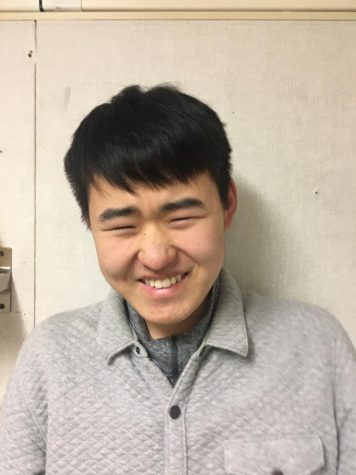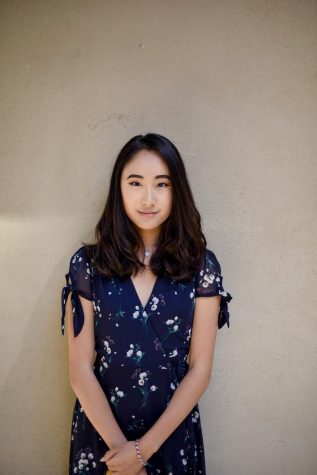Meet your teacher: Biology teacher experiences joy of beekeeping
In this installment of “Meet Your Teacher”, Dr. Thomas Artiss discusses his apiary love.
Biology teacher Dr. Thomas Artiss tends to a beehive. “I could stand and watch the hive for half an hour,” Artiss said.
A low buzzing fills the air as biology teacher Dr. Thomas Artiss approaches his beehive. Clad in traditional beekeeper wear — wide brimmed hat, mesh faceguard, white full-body suit and all — Dr. Artiss is the image of an accomplished apiarist.
“I dabbled in entomology for my doctoral thesis, and I’ve been interested in social insects for a long time, sort of from a biological perspective, but I’ve been thinking about beekeeping for several years,” Dr. Artiss said. “About two years ago, my wife and step-kids got me a beehive for father’s day, so at that point, I was kind of committed to it.”
Dr. Artiss’ first attempt at raising a colony failed, as he established it too late in the year and the bees did not have the time necessary to build up enough reserves to survive the winter.
“I was disheartened,” he said. “But I contacted someone who got me something called a swarm, which is a box with a queen and another colony, and I got it up and running in May this year. And when I started to realize that this colony was going to take, I was pretty excited.”
Dr. Artiss’s favorite part of his hive is not the honey he can harvest, nor any profits to be made from harvesting honey.
“I feel like I’m actually doing something good,” he said. “I feel I’m establishing a group of insects that are going to help pollinate wildflowers and trees in my community, which, ultimately, is going to make the area around which I live that much better.”
Dr. Artiss plans to bring his hobby into the classroom, with the incorporation of bees, wasps, leafcutter ants and other social insects into his curriculum. He is currently working on obtaining an observation hive for the upper school campus, which will house a colony of bees behind plexiglass for students to watch and study.
Dr. Artiss hopes to use this hive to showcase the various habits and behaviors of bees, such as the “waggle” dance.
“It’s actually a method of bee communication,” Dr. Artiss said. “A worker bee who has found a small patch of nectar or pollen will return back to the hive and tell other members of the hive where the food was found by doing a waggle dance… and what they’ve found is that the angle of the dance is proportionate to the angle of the sun and the number of waggles indicates the distance. So [the bees are] able to communicate where food is with an angle and a distance so that other workers can go out and exploit the patch.”
Dr. Artiss enjoys sharing his love of science with his students and has pointed out this dance to them before, namely on last year’s eighth grade class trip to Washington, D.C.
“We went to the [Smithsonian] Natural History Museum, and in there they have an enormous observation hive, and I stood by the observation hive for the two or three hours we were in the Natural History Museum,” he said. “Any time an eighth grader would walk by I would be grabbing them, pulling them over, and going ‘Look! Look! Look! They’re doing the waggle dance!’”
Dr. Artiss’ interests do not stop at just an observation hive. Next summer he hopes to go to research with a friend at the Smithsonian Natural History Museum, who researches leafcutter ants — social insects similar to bees — and to perhaps secure a colony to bring back to Harker with him.
“You have to get all sorts of USDA permits and that sort of thing, but the bottom line is, with an observation hive and leaf harvesting ants, the opportunity to have lessons that we could bring into the classroom are there,” he said.
With these new lesson plans in mind, Dr. Artiss aims to fulfill his goal — inspiring enthusiasm among students.
“My goal in teaching has always been to teach to the students that are the biggest cynics in the room because I feel like the ones who love biology are going to love it no matter what I do,” he said. “Every student in my class is there because they have to be, not necessarily because they want to be. And so, I know 10 or 20 or 30 percent of those students have no interest in science or biology and have already made up their minds, and I want them to leave my classroom at least once and say ‘Wow, that was really cool’ or ‘Hey, that lab or activity was so cool’ or to say ‘I can’t wait to come to Artiss’ class tomorrow.’”
This piece was originally published in the pages of The Winged Post on Aug. 31, 2018.
Correction: Sept. 4, 2018
A previous version of this article misquoted Dr. Artiss’ doctoral thesis as etymology. The article has been edited to correct this error.

Jessie Wang (12) is the senior copy editor for the Winged Post and Harker Aquila. This is his fourth and final year on staff, and he hopes to continue...

Kathy Fang (12) is the editor-in-chief of Harker Aquila. This is her fourth year on staff. From covering local marches and protests to initiating Harker...


















![“[Building nerf blasters] became this outlet of creativity for me that hasn't been matched by anything else. The process [of] making a build complete to your desire is such a painstakingly difficult process, but I've had to learn from [the skills needed from] soldering to proper painting. There's so many different options for everything, if you think about it, it exists. The best part is [that] if it doesn't exist, you can build it yourself," Ishaan Parate said.](https://harkeraquila.com/wp-content/uploads/2022/08/DSC_8149-900x604.jpg)




![“When I came into high school, I was ready to be a follower. But DECA was a game changer for me. It helped me overcome my fear of public speaking, and it's played such a major role in who I've become today. To be able to successfully lead a chapter of 150 students, an officer team and be one of the upperclassmen I once really admired is something I'm [really] proud of,” Anvitha Tummala ('21) said.](https://harkeraquila.com/wp-content/uploads/2021/07/Screen-Shot-2021-07-25-at-9.50.05-AM-900x594.png)







![“I think getting up in the morning and having a sense of purpose [is exciting]. I think without a certain amount of drive, life is kind of obsolete and mundane, and I think having that every single day is what makes each day unique and kind of makes life exciting,” Neymika Jain (12) said.](https://harkeraquila.com/wp-content/uploads/2017/06/Screen-Shot-2017-06-03-at-4.54.16-PM.png)








![“My slogan is ‘slow feet, don’t eat, and I’m hungry.’ You need to run fast to get where you are–you aren't going to get those championships if you aren't fast,” Angel Cervantes (12) said. “I want to do well in school on my tests and in track and win championships for my team. I live by that, [and] I can do that anywhere: in the classroom or on the field.”](https://harkeraquila.com/wp-content/uploads/2018/06/DSC5146-900x601.jpg)
![“[Volleyball has] taught me how to fall correctly, and another thing it taught is that you don’t have to be the best at something to be good at it. If you just hit the ball in a smart way, then it still scores points and you’re good at it. You could be a background player and still make a much bigger impact on the team than you would think,” Anya Gert (’20) said.](https://harkeraquila.com/wp-content/uploads/2020/06/AnnaGert_JinTuan_HoHPhotoEdited-600x900.jpeg)

![“I'm not nearly there yet, but [my confidence has] definitely been getting better since I was pretty shy and timid coming into Harker my freshman year. I know that there's a lot of people that are really confident in what they do, and I really admire them. Everyone's so driven and that has really pushed me to kind of try to find my own place in high school and be more confident,” Alyssa Huang (’20) said.](https://harkeraquila.com/wp-content/uploads/2020/06/AlyssaHuang_EmilyChen_HoHPhoto-900x749.jpeg)



